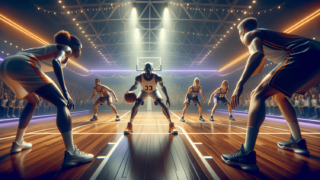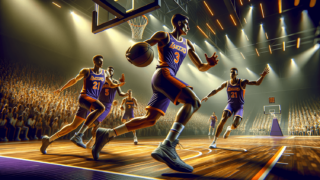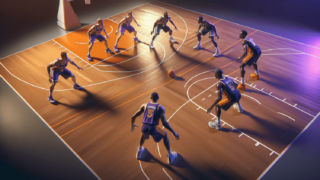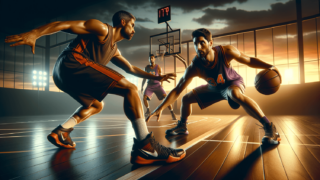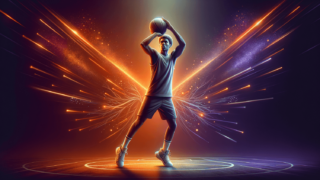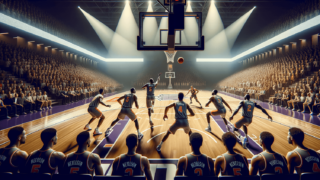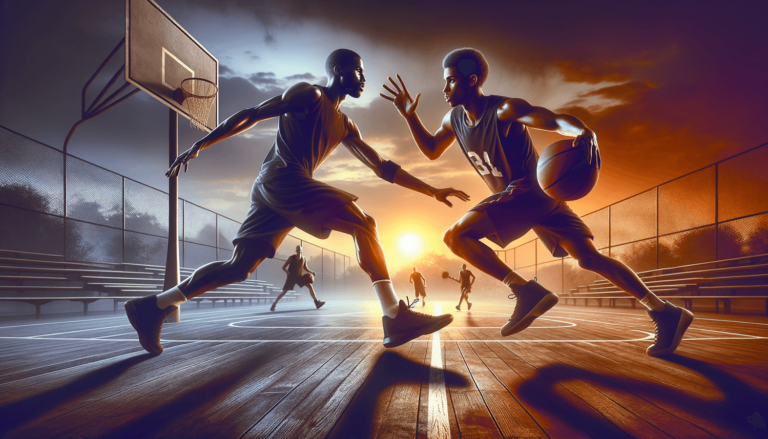
How to Improve Your Basketball One-on-One Skills?
Written by: Basketball Universe
Last updated:

Get ready to level up your game, hoop enthusiasts! A solid one-on-one performance in basketball can be the ultimate showdown of grit, skill, and strategy. Honing these skills not only boosts your individual prowess but elevates your overall game too. In this comprehensive guide on ‘How to Improve Your Basketball One-on-One Skills?’, we’ll cover everything from physical and mental conditioning, to breaking down the best moves and counter-moves to dominate the court. So lace up those sneakers, and let’s dive into the world of basketball mastery, one tactic at a time.
How to Improve Your Basketball One-on-One Skills?
To improve your basketball one-on-one skills, focus on enhancing your dribbling, shooting, and defensive techniques, as well as strengthening your physical and mental conditioning. By practicing drills dedicated to each aspect, studying your opponents’ moves, and incorporating strategic plays into your game, you’ll quickly become a force to be reckoned with on the court.
Master the Art of Dribbling
To excel in one-on-one basketball, you need to have a strong foundation in dribbling. This skill is crucial for maintaining possession of the ball and navigating the court effectively. Here are some techniques and drills to help you refine your dribbling prowess:
Crossovers and Change of Pace
Defensive players thrive on predictability, but you can break their rhythm by practicing crossover dribbling and altering your pace. Start by dribbling from one end of the court to the other using a standard dribble. Gradually increase your speed, then suddenly shift to a crossover dribble as you approach the defender. This sudden change of pace and direction will leave them scrambling.
Behind-the-Back Dribble
Adding a behind-the-back dribble to your arsenal can catch your defender off-guard, creating opportunities to drive past them. Practice this move by dribbling the ball from one hand to the other behind your back while maintaining control. This fancy dribble takes time to master, but the element of surprise it brings is worth the effort.
Two-Ball Dribbling Drills
These drills will challenge your coordination and improve your ball control skills. Begin with a simultaneous dribble using both hands and two basketballs. Progress to one ball dribbling high while the other dribbles low and then switch. Finally, try alternating dribbles between your left and right hand with different rhythms. The goal is to become comfortable handling two basketballs at once, making the task of handling one ball even easier.
Develop a Sharp Shooting Eye
Having a versatile shooting range can keep your defender guessing and create scoring opportunities in one-on-one situations. Implement these shooting tips and drills to elevate your game:
Master the Basics
Understanding the fundamentals of shooting is critical for accuracy and consistency. Key components include proper grip, balanced stance, good shooting mechanics, and following through with a smooth release. Focus on these fundamentals during practice drills to ingrain proper muscle memory.
Step-Back Jumpers
A step-back jumper is a valuable asset for one-on-one play. It allows you to create space from your defender for an open shot. Practice this by driving towards the basket, stopping abruptly, and stepping back into a jumper as you break free from your defender.
Fadeaway Shots
Fadeaway shots rely on your ability to shoot while leaning away from the defender, creating extra separation. Practice shooting fadeaways by setting up near the basket, jumping away from the hoop while shooting, and gradually increasing the distance as you become more comfortable with the motion.
Create Your Own Shot
One-on-one basketball forces you to create your own shot opportunities, so take time to identify your strengths and weaknesses. Discover the spots on the court where you’re most comfortable shooting from, and build a go-to collection of moves that draw from those areas.
Dominate on Defense
Defense wins games, and the ability to shut down your opponent in one-on-one situations is just as important as your offensive skills. Here are some tips and drills to boost your defensive game:
Defensive Stance and Footwork
A proper defensive stance with active footwork is essential in stopping an opponent. Bend your knees and stay low, keeping your feet shoulder-width apart and your weight distributed evenly. Practice footwork drills such as the defensive slide, drop step, and closeout to improve your lateral movement and agility on defense.
Body Control and Balance
Controlling your body while engaging with an offensive player is vital to maintain a strong defensive presence. Practice maintaining balance while anticipating and reacting to your opponent’s moves. Drills that incorporate plyometrics and core strength exercises can help develop body control and stability.
Reading and Anticipating Your Opponent
Successful one-on-one defense hinges on your ability to anticipate your opponent’s intentions. Study your opponent’s tendencies and use this knowledge to predict their next move. Notice if they favor a particular hand, prefer a specific shot, or have a go-to play they frequently rely on.
Physical Conditioning: Train Like a Pro
Physical fitness plays a significant role in one-on-one basketball performance. Incorporate these conditioning exercises into your routine to enhance your athleticism on the court:
Strength Training
Building muscle can improve your explosiveness, speed, and agility, providing a solid foundation for both offensive and defensive capabilities. Utilize compound exercises like squats, lunges, and deadlifts to target multiple muscle groups simultaneously, maximizing your basketball-specific strength gains.
Speed and Agility Training
Drills that focus on speed, agility, and quickness can sharpen your reflexes and help you stay one step ahead of your opponent. Incorporate ladder drills, cone drills, and short-burst sprints into your training regimen to improve your court performance.
Stretching and Flexibility
Flexibility aids in injury prevention and allows for a greater range of motion during play. Dedicate time to stretching both before and after your workouts and games, focusing on key muscle groups used in basketball, such as your legs, hips, back, and shoulders.
Mental Preparation: Train Your Mind
Preparing your mind for one-on-one basketball is just as vital as physical training. Here’s how to elevate your mental game:
Build Confidence
Believe in your skills and abilities, even when faced with adversity. Positive affirmation and visualization techniques can help boost your self-confidence, allowing you to trust in your abilities when facing a tough opponent.
Stay Focused
One-on-one basketball success requires mental toughness and the ability to remain focused. Accept mistakes, learn from them, and refocus your energy on the next play or game. Avoid distractions and stay committed to your personal improvement.
Study the Game
Knowledge is power. Watch game footage, study expert players, and embrace continuous learning to gain a deeper understanding of the game. This will enable you to make informed decisions and adjustments in real-time, giving you an edge over your competition.
With dedication, practice, and strategic development of your one-on-one skills, you’ll transform into an impressive basketball player on and off the court. Use these tips and drills to enhance your performance and enjoy the thrilling journey towards basketball mastery.
Embrace Basketball IQ
Developing your Basketball IQ, or your understanding of the game’s intricacies, can elevate your one-on-one skills to new heights. Whether it’s assessing a specific situation on the court or detecting patterns in your opponent’s playing style, a high Basketball IQ can give you the edge you need.
Learn from the Pros
Study professional basketball players known for their one-on-one abilities, such as Michael Jordan, Kobe Bryant, and Lebron James. Observe their moves, analyze their decision-making processes, and look for patterns that you can incorporate into your own game. This study can provide invaluable lessons and insight into advanced techniques you would otherwise miss.
Master Game Theory
Game theory is about understanding how players make decisions and interact in a competitive environment. In a one-on-one situation, you and your opponent are constantly trying to anticipate each other’s moves. Develop a strong grasp of game theory by examining plays from professional games, analyzing opponent tendencies, and challenging yourself mentally during practice sessions.
Enhance Your Offensive Arsenal
Refining your offensive skills can turn you into an unstoppable one-on-one player. Here are a few advanced moves to add to your offensive toolbox:
Up-and-Under Move
Deception is essential in one-on-one basketball, and the up-and-under move is an effective weapon to have. Perform this move by starting a fake shot, waiting for your defender to jump in response, and then pivoting under their outstretched arms for an open layup or jump shot.
Euro Step
Popularized by NBA stars such as Manu Ginóbili and James Harden, the Euro step is a great way to bypass defenders while driving to the basket. This move involves taking a step in one direction before explosively stepping in the opposite direction to evade the defender. When executed correctly, the Euro step can leave your opponent baffled and off-balance.
Jab Step
One of the simplest yet most effective offensive tools available, the jab step can catch defenders off-guard and create space for a clean shot. By feinting a step in one direction and then quickly shifting back to your original stance, you can throw off your opponent and take advantage of the open space provided.
Strengthen Your Defensive Tenacity
Incorporate advanced defensive techniques into your game to lock down your one-on-one opponent and become a defensive nightmare:
Show Active Hands
A strong one-on-one defender never allows their hands to remain idle. Keep them active, placing them in the passing lanes or attempting to disrupt the offensive player’s dribbling action. This increased pressure can lead to turnovers and leave your opponent feeling flustered.
Master Shot Blocking
Shot blocking prowess can demoralize your opponent and prevent potential points. Work on your timing and vertical leap to enhance your shot-blocking ability. Remember, a well-timed jump can be just as effective as raw athleticism.
Adopt a Never-Give-Up Attitude
Defensive tenacity can make up for any physical limitations you may have on the court. Adopt a relentless mindset, always maintaining pressure on your opponent and giving them no easy opportunities. Your hard work and dedication will pay dividends in your one-on-one defense.
By integrating this additional information into your basketball training, you will continue to develop your one-on-one skills and become an even more complete player. Remember, practice makes perfect, and building your basketball prowess takes time and dedication. Stay committed, and enjoy witnessing the fruits of your labor in each one-on-one victory.
FAQ Section: Master Your One-on-One Basketball Skills
Still have questions about improving your basketball one-on-one skills? Check out our FAQ section that addresses common inquiries to help clarify concepts and guide you on your journey to basketball dominance.
1. How often should I practice to see improvements in my one-on-one skills?
While the frequency of practice is subjective and depends on individual goals and commitments, it is generally recommended to practice at least 3-4 times a week to see noticeable improvements in your one-on-one skills. Dedicate time to specific skills and drills, and remember consistency is key.
2. What’s the best way to practice one-on-one skills alone?
When practicing alone, focus on areas such as dribbling, shooting, defensive footwork, and physical conditioning exercises. You can use a wall or a dummy defender to mirror real game situations and improve your skills in those areas. Regularly assess your progress to stay motivated and goal-oriented.
3. Can I use outdoor courts for practicing one-on-one skills?
Absolutely! Outdoor courts can be a great resource for improving one-on-one skills. Keep in mind that surface conditions may differ, so adjust your practice accordingly, and prioritize safety by wearing appropriate gear and being cautious of uneven or slippery surfaces.
4. What types of footwear are best for mastering one-on-one skills?
Picking the right footwear is crucial for both performance and injury prevention. Select basketball shoes that provide ample ankle support, cushioning, and good traction, specific to your playing style and personal preference. Try different models and brands to find the best fit and comfort for your feet.
5. What should I do if I hit a plateau in my one-on-one skill development?
Plateaus are common in any skill development journey. Overcome these obstacles by reassessing your goals and strategies. Shake up your practice routine, seek feedback, learn from others, and stay patient. Be persistent, and you’ll eventually break through the plateau.
6. How can I improve my mental toughness in one-on-one basketball situations?
Mental toughness is built through practice, patience, and persistence. Challenge yourself during workouts, set realistic goals, and learn to accept setbacks as learning opportunities. Maintain focus, avoid distractions, and commit to continuous improvement to develop mental resilience on the court.
7. How can I practice defense without an opponent?
Although practicing defense without an opponent is challenging, you can work on your defensive stance, footwork, and body control through specific drills, plyometrics, and agility exercises. Visualize defensive situations and analyze game footage to develop mental preparedness and Basketball IQ.
8. How important is my diet in improving my one-on-one skills?
A well-balanced diet is essential to unlocking your full potential in basketball. Proper nutrition fuels your body, helps with muscle recovery, and increases overall performance. Consult a nutritionist or coach to devise a meal plan that supports your basketball, strength training, and conditioning goals.
9. Are there any specific warm-up routines for one-on-one basketball?
A proper warm-up is crucial to prevent injuries and optimize performance. Ideal warm-up routines for one-on-one basketball should include a combination of dynamic stretches, sport-specific movements, and light cardiovascular exercises that activate relevant muscle groups and elevate your heart rate.
10. How can I improve my decision-making skills in one-on-one basketball?
Decision-making skills improve with experience, practice, and discipline. Analyze game footage, study advanced basketball strategies, and challenge yourself in high-pressure situations to learn and adapt. Over time, you’ll become more intuitive and confident in your decision-making abilities during one-on-one basketball play.
Featured Posts
- No pillar pages found.
